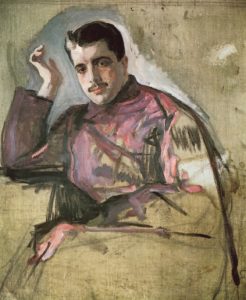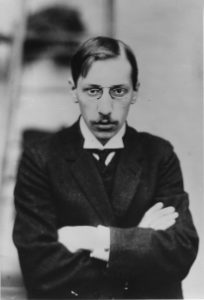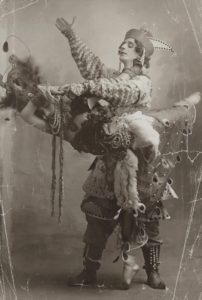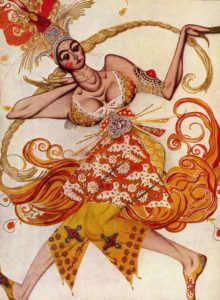
March 14, 2018
The Ultimate Russian Fairytale: Stravinsky’s The Firebird
In 1909, the Russian impresario Sergei Diaghilev was running out of time. After a grand duke who had been a key backer of his ventures dropped dead and his widow refused to give him any more money, Diaghilev had been forced to abandon his plans to present Russian opera in Paris in the spring of 1910. Instead, he would present the more cost-effective art form of ballet.
For Russian Export

In recent years, Paris had been swept by a vogue for all things Russian—especially art and music that confirmed the Western view of Russia as a wild, semi-barbaric land. Having burned some bridges with the artistic establishment back in Russia, Diaghilev was quick to capitalize on the tastes of the Parisian public with performances of Russian operas, ballets and concert music. While some of what he produced was merely crowd pleasing, he also hoped Paris would give him an opportunity to put his theories about art into practice.
Before beginning his trips to Paris, Diaghilev had been the leader of one of Russia’s most prominent arts publications, Mir Iskusstva, or “The World of Art,” which had advocated for a Wildean aestheticism, a hedonistic “art for art’s sake” mentality that critics would decry as “decadence.” The Miriskusniki, as followers of the journal were known, dreamed of creating a totally integrated work of art with an overwhelming combination of music, theater, and visual design that would be fresh and new yet rooted in traditional Russian folk art. One of the symbols of the movement was a character from Russian folklore that symbolized rebirth, beauty and magic: the firebird. The highlight of the 1910 season would thus be a new ballet based on her that would finally realize the Miriskusniki’s ideals and show Paris and all the world that Russian art was at the cutting edge of sophistication.
The Man for the Job

Originally he planned to hire the composer Tcherepnin (with whom he had worked before) to write the music, but Tcherepinin dropped out. Next he turned to Lyadov, a composer known for his music inspired by Russian folklore, but despite some initial interest, Lyadov also backed out, possibly because the project came at such short notice. Diaghilev also briefly considered Glazunov, the leading composer in Russia at the time, but nothing came of it. Running out of options, he turned to a young, relatively untested composer that he had commissioned to orchestrate two pieces by Chopin for a ballet the year before: Igor Stravinsky. Stravinsky had been a student of Rimsky-Korsakov, so at the very least he would be technically proficient, and being little-known, he would likely say yes to anything.
Diaghilev was right. Stravinsky got to work even before Diaghilev had made him a formal offer, though most of his initial sketches had to be discarded as the details of the ballet’s plot and structure morphed. Eager to make the ballet as Russian as possible, Diaghilev’s team concocted a story that combined the most famous characters from half-a-dozen Russian fairytales, including the Firebird, Prince Ivan-Tsarevich, thirteen dancing princesses and the evil sorcerer-king Kashchey the Deathless. This particular cast was undoubtedly inspired by an excerpt from Polonsky’s famous poem A Winter’s Journey, which Russian children still recite today:
…And in my dreams I see myself on a wolf’s back
Riding along a forest path
To do battle with a sorcerer-tsar
In that land where a princess sits under lock and key,
Pining behind massive walls.
There gardens surround a palace all of glass;
There Firebirds sing by night
And peck at golden fruit;…

Stravinsky often worked directly with the demanding choreographer Michel Fokine, who would dictate many details of how the music should unfold. Fokine later recalled a scene that gives some sense of their working method:
“I remember how he brought me a beautiful Russian melody for the entrance of Ivan-Tsarevich. I suggested not presenting the complete melody all at once, but just a hint of it, by means of separate notes, at the moments when Ivan appears at the wall, when he observes the wonders of the enchanted garden, and when he leaps over the wall.
“Stravinsky played, and I interpreted the role of Tsarevich, the piano substituting for the wall. I climbed over it, jumped down from it, and crawled, fear-struck, looking around—my living room. Stravinsky, watching, accompanied me with patches of the Tsarevich melodies, playing mysterious tremolos as background to depict the garden of the sinister Kashchey the Deathless…”
As the most junior member of the creative team, Stravinsky put up with Fokine’s caprices and wrote the music to his requirements. It is a testament to the 27-year-old composer’s burgeoning genius that even so the score turned out to be one of the young century’s most iconic masterpieces.
The son of one of Russia’s leading opera singers, Stravinsky grew up surrounded by music, although he only began to pursue it seriously at 17. After having befriended Rimsky-Korsakov’s son in law school, he began studying privately with Russia’s most prominent living composer every Wednesday, often staying to dinner. He progressed quickly under Rimsky-Korsakov’s tutelage, producing an accomplished set of student works that included a piano sonata and a symphony. Dutiful disciple though he was, he became increasingly attracted to Miriskusniki decadence, which Rimsky-Korsakov viewed with suspicion. In this ballet, the first major work he was to complete after his teacher’s death in 1908, Stravinsky would put Rimsky-Korsakov’s musical language to work in a Miriskusniki ballet; he thus pays homage to his teacher and moves beyond him.
The premiere of the ballet on June 25, 1910 caused a sensation, catapulting Stravinsky to international fame overnight. A suite was prepared for performance the following year, but was supplanted by a new suite issued by the composer in 1919. This version, which contains the ballet’s most memorable numbers, is the one most often performed today.
The Music
The suite begins with the opening of the ballet, which depicts the magic garden of Kashchey the Deathless shrouded in darkness:
In a tradition stretching back to Glinka’s opera Ruslan and Lyudmila (1842), Russian composers used strange, chromatic scales and harmonies to depict supernatural forces and simpler, more “natural” folk melodies to represent human characters. Stravinsky continues this tradition throughout The Firebird, starting with the sepulchral opening for cellos, basses and bass drum.

The following movement depicts the firebird’s appearance and her subsequent dance. The firebird’s music employs harmonies similar to those of the dark opening music, but faster and orchestrated in brilliant, flaming colors. She is after all, like Kashchey, a supernatural being. The firebird is pursued by Prince Ivan, who catches her. Moved by her beauty, he allows her to go free. In gratitude, the firebird gives him one of her feathers, telling him that she will soon return his kindness.
Soon after thirteen princesses imprisoned by Kashchey appear in the garden. The third movement depicts their korovod, or round dance. The melody of the dance is actually a traditional Russian folk song that Rimsky-Korsakov also used in his Sinfonietta. This melodic borrowing is just one of many nods Stravinsky would maker to his teacher’s music in The Firebird. Prince Ivan falls in love with one of the princesses, but Kashchey and his retinue soon capture him. Remembering the feather, Prince Ivan calls on the firebird for help. She appears and uses her magic to make Kashchey and his followers dance.
The fourth movement of the suite, the Infernal Dance, borrows its main melody from a passage in Rimsky-Korsakov’s opera Mlada that represented a witches’ sabbath. Stravinsky’s genius for rhythm, however, transforms the idea with syncopations and a series of musical lightning bolts that startled many unsuspecting attendees of the Paris premiere.
The firebird ultimately triumphs, and Kashschey and his creatures fall into a deep slumber, exhausted from the dance. This corresponds to the beginning of the fifth movement, the firebird’s lullaby, a haunting melody for bassoon. She shows Prince Ivan where to find the egg that holds Kashchey’s soul, and he breaks it, killing Kashchei and undoing his evil magic (the legend of Kashchey the Deathless’s egg likely inspired J. K. Rowling’s horcruxes).
The resplendent finale begins with a horn solo based on a melody from a collection of folk songs that Rimsky-Korsakov had published (Tchaikovsky had also arranged the same melody for two pianos). The theme is repeated, building to an exhilarating ending. The chromatic chords that end the ballet outline the firebird’s motif, bringing the suite to a magical conclusion. —Calvin Dotsey
Don’t miss Stravinsky’s Suite from The Firebird March 29, 30 & 31! Get tickets and more information at houstonsymphony.org.






